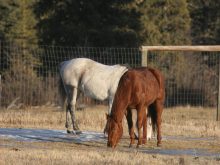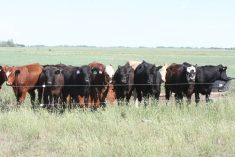The bacteria Ureaplasma diversum, a common inhabitant of the genital tract of cattle, was first isolated in 1969 and originally wasn’t considered to be a disease threat.
However, subsequent research, mostly in Canadian veterinary colleges in the 1970s and 1980s, suggested that Ureaplasma could be associated with failure of pregnancy at various times of gestation in cattle.
In cows, the bacterium is thought to cause an inflammatory condition in the vaginal wall that may produce reddening and the formation of granules. In some cases, there may also be vaginal discharge.
Read Also

Fog fever, or ‘the grunts,’ spells trouble for beef cattle
Whether you call it fog fever or something else, this illness means trouble for cattle. Learn what triggers the disease and how to prevent it.
Ureaplasma and Mycoplasma are both members of the Mollicutes class of bacteria. The word mollicutes comes from a Latin word which means “soft or pliable” and refers to the fact that they are very small bacteria that lack a cell wall.
They are finicky to grow in the laboratory and require very special media and conditions in which to grow.
Genetic fingerprinting and PCR testing can now make it easier to identify these types of bacteria and show when they are present without complicated culture methods.
These bacteria are opportunistic, in that they can be found in completely healthy animals, but given the right conditions, they may also be able to cause disease.
Mycoplasma bovis is a classic example of an opportunistic bacteria. It is a common inhabitant of the nasal cavity of cattle but has been shown to cause chronic pneumonia and arthritis in feedlot cattle.
Ureaplasma can similarly be found in the reproductive tract of normal animals but may be associated with infertility or abortions in certain situations. In fact, most of the bacteria and viruses that are associated with respiratory disease in cattle would be classed as opportunists.
A recent study published in the Australian Veterinary Journal demonstrates the potential for Ureaplasma diversum to be implicated in more than just infertility problems in cattle.
Researchers took nasal swabs from 216 apparently healthy animals at the time of arrival at a feedlot and again at 14 days after arrival. They also took nasal swabs from 34 hospital pen animals that were mostly being treated for respiratory disease or lameness. They then used a PCR test to identify whether Ureaplasma was present in any of the nasal swabs.
Ureaplasma was detected in the healthy cattle at a relatively low level. At arrival, 6.9 percent were positive for Ureaplasma in their nasal swabs, which increased to 9.7 percent percent by day 14. However, when researchers tested cattle from the hospital pen, a significantly higher proportion of those cattle tested positive — 58.8 percent.
The authors also attempted to isolate a number of other bacteria and viruses from the cattle to determine if there were other infections that commonly occurred in combination with Ureaplasma. They noted that of the cattle in the hospital pen that were positive for Ureaplasma and were being treated for respiratory disease, 90 percent were also positive for Mycoplasma bovis.
Does this mean Ureaplasma is a potential bacterial cause of respiratory disease in cattle? It is a possible explanation for these results, but the study doesn’t prove that conclusively. The fact that Ureaplasma was much more commonly isolated in cattle in the hospital pen is certainly interesting, but the question probably warrants further study and will require more research to prove it conclusively.
However, it perhaps isn’t a surprising finding. We know that Mycoplasma bovis is associated with respiratory disease and Ureaplasma is a similar organism. In addition, a handful of other reports from Belgium and Finland have suggested Ureaplasma might be associated with respiratory disease outbreaks in calves.
This particular study didn’t give a lot of details about the induction process at the feedlot. We also don’t know the exact treatment histories of the cattle in the chronic pen and so we don’t know what role antimicrobial treatment may have played in changing the cattle’s microbiome.
The study does demonstrate that Ureaplasma can be found in more than just the reproductive tract of cattle, and that it may be one of the many opportunistic bacteria and viruses that can be associated with the respiratory disease syndrome.
It will require more research to explore the true significance of this organism. The new tools being employed to study the microbiome and the genomic identification of pathogens will undoubtedly be part of those investigations.
John Campbell is a professor in the department of Large Animal Clinical Sciences at the University of Saskatchewan’s Western College of Veterinary Medicine.















